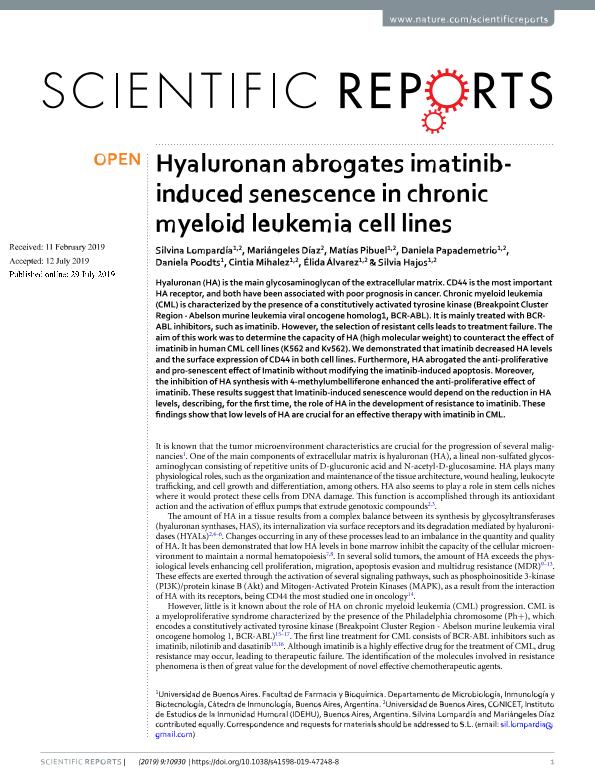Artículo
Hyaluronan abrogates imatinib-induced senescence in chronic myeloid leukemia cell lines
Lompardía, Silvina Laura ; Díaz, Mariángeles
; Díaz, Mariángeles ; Pibuel, Matías Arturo
; Pibuel, Matías Arturo ; Papademetrio, Daniela Laura
; Papademetrio, Daniela Laura ; Poodts, Daniela; Mihalez, Cintia Yamila
; Poodts, Daniela; Mihalez, Cintia Yamila ; Alvarez Carbonetto, Elida M. del C.
; Alvarez Carbonetto, Elida M. del C. ; Hajos, Silvia Elvira
; Hajos, Silvia Elvira
 ; Díaz, Mariángeles
; Díaz, Mariángeles ; Pibuel, Matías Arturo
; Pibuel, Matías Arturo ; Papademetrio, Daniela Laura
; Papademetrio, Daniela Laura ; Poodts, Daniela; Mihalez, Cintia Yamila
; Poodts, Daniela; Mihalez, Cintia Yamila ; Alvarez Carbonetto, Elida M. del C.
; Alvarez Carbonetto, Elida M. del C. ; Hajos, Silvia Elvira
; Hajos, Silvia Elvira
Fecha de publicación:
12/2019
Editorial:
Nature Publishing Group
Revista:
Scientific Reports
ISSN:
2045-2322
e-ISSN:
2045-2322
Idioma:
Inglés
Tipo de recurso:
Artículo publicado
Clasificación temática:
Resumen
Hyaluronan (HA) is the main glycosaminoglycan of the extracellular matrix. CD44 is the most important HA receptor, and both have been associated with poor prognosis in cancer. Chronic myeloid leukemia (CML) is characterized by the presence of a constitutively activated tyrosine kinase (Breakpoint Cluster Region - Abelson murine leukemia viral oncogene homolog1, BCR-ABL). It is mainly treated with BCR-ABL inhibitors, such as imatinib. However, the selection of resistant cells leads to treatment failure. The aim of this work was to determine the capacity of HA (high molecular weight) to counteract the effect of imatinib in human CML cell lines (K562 and Kv562). We demonstrated that imatinib decreased HA levels and the surface expression of CD44 in both cell lines. Furthermore, HA abrogated the anti-proliferative and pro-senescent effect of Imatinib without modifying the imatinib-induced apoptosis. Moreover, the inhibition of HA synthesis with 4-methylumbelliferone enhanced the anti-proliferative effect of imatinib. These results suggest that Imatinib-induced senescence would depend on the reduction in HA levels, describing, for the first time, the role of HA in the development of resistance to imatinib. These findings show that low levels of HA are crucial for an effective therapy with imatinib in CML.
Archivos asociados
Licencia
Identificadores
Colecciones
Articulos(IDEHU)
Articulos de INST.DE EST.DE LA INMUNIDAD HUMORAL PROF.R.A.MARGNI
Articulos de INST.DE EST.DE LA INMUNIDAD HUMORAL PROF.R.A.MARGNI
Citación
Lompardía, Silvina Laura; Díaz, Mariángeles; Pibuel, Matías Arturo; Papademetrio, Daniela Laura; Poodts, Daniela; et al.; Hyaluronan abrogates imatinib-induced senescence in chronic myeloid leukemia cell lines; Nature Publishing Group; Scientific Reports; 9; 1; 12-2019; 1-11
Compartir
Altmétricas



